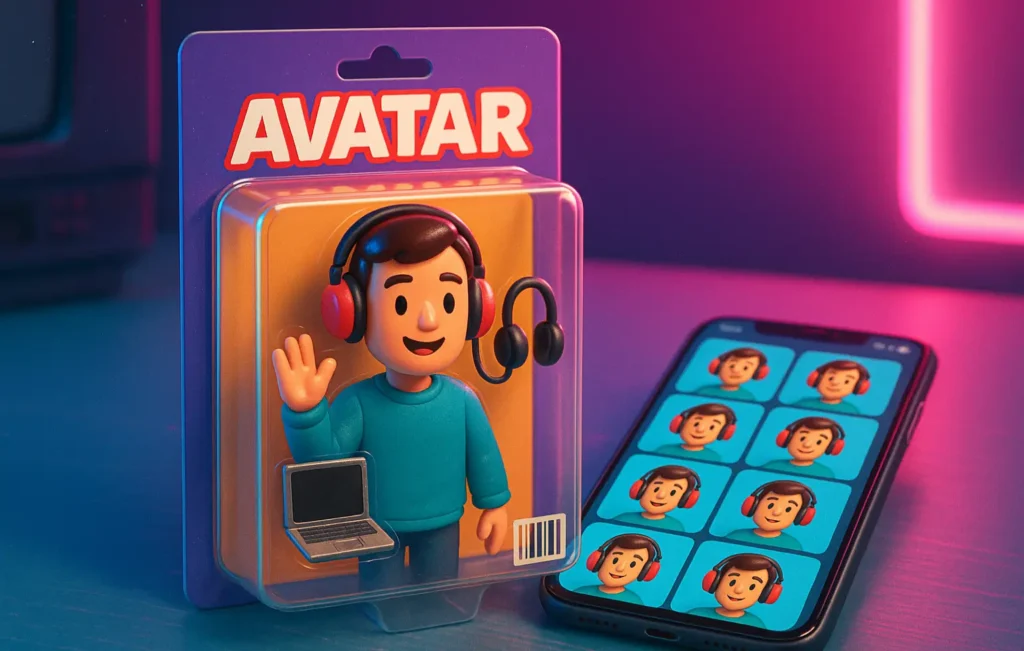Figurine-style AI avatars—mini “action figure” portraits inside toy-like boxes—spread because design psychology, frictionless creation, and social platform dynamics combine at a culturally nostalgic moment. Google’s “Nano Banana” plugs into a system that rewards cute clarity, personalization, and templated remixing that fuels parasocial engagement loops.

The Supply Chain Of Virality
Figurine-style images ride a “supply chain” from instant creation to mass distribution, where each stage strengthens the next.
Frictionless Creation
- Fast, consistent outputs from a single selfie or prompt lower the creation barrier to near zero.
- Studio-like “toy shelf” polish raises post-worthiness and encourages rapid iteration.
Templated Uniqueness
- The boxed-figurine template is fixed, but accessories, labels, and poses personalize identity.
- Each share looks unique yet recognizable as “of the trend,” inviting imitation.
Social Proof And Cascade
- Early adopters, creators, and public figures normalize the format, triggering herd effects.
- How-to guides and prompt recipes standardize quality, accelerating mainstream uptake.
The Design Psychology: Cute, Concrete, Collectible
The visual language is engineered to stop the scroll and invite sharing.
Kawaii Cues
- Exaggerated proportions and simplified forms heighten approach motivation and careful attention.
- “Cute” primes supportive affect and increases feed-level legibility.
Concrete Narrative Hooks
- Box art, accessories, and “series names” provide plug-and-play identity stories.
- Concreteness reduces cognitive load versus open-ended portrait edits.
The Collectible Frame
- Packaged, series-like presentation taps the collector mindset.
- Repeated “drops” (variations on a self) feel like building a set worth displaying.
Identity Play Meets Parasocial Fuel
Figurines make low-risk identity experimentation shareable and sticky.
Aspirational Selves
- Users “try on” roles—DJ, coder, athlete—satisfying autonomy and competence needs.
- Stylized avatars balance self-likeness with fantasy, making posts feel safe yet bold.
Parasocial Reinforcement
- Audiences respond as if to a character, strengthening creator–viewer ties.
- Each iteration compounds recognition and future engagement.
Algorithmic Compatibility By Design
The format maps to what feeds reward.
Immediate Visual Clarity
- The “toy-in-a-box” silhouette is instantly legible in crowded feeds.
- High contrast, centered subject, and fixed framing help thumbnail performance.
Recognizable Novelty
- A stable template provides familiarity; endless themes provide fresh variation.
- Algorithms identify high retention patterns in remixable formats.
High-Velocity Iteration
- Quick generation enables A/B testing across themes in a single session.
- More posts create more signals, letting algorithms surface winners.
The Nostalgia Engine
Adult users who grew up with 80s/90s toy lines feel a warm pull toward the format.
Collective Memory Triggers
- Box corners, blister-card vibes, VHS textures, and hero tropes cue shared memories.
- Nostalgia boosts mood, sharing, and comment positivity.
Dual Identification
- People enter beloved narrative worlds while remaining the protagonist.
- Self-as-franchise crossover deepens sub-community resonance.
Zero-Friction Tools Tip The Balance
Speed, likeness retention, and no-cost access distinguish this moment.
Pro-Look Without Expertise
- Photoreal toy aesthetics and consistent likeness make casual users feel “pro.”
- No 3D software or compositing skills required.
The Learning Loop
- Prompt lists, celebrity examples, and walkthroughs compress onboarding.
- Each cohort onboards the next, sustaining exponential spread.
Second-Order Effects
The trend reshapes creator workflows, platform features, and ethics discourse.
Creator Economy
- Commissions for custom figurines, prompt packs, and themed “series” emerge.
- Brands adopt limited “boxed” drops for launches and fandom engagement.
Platform Productization
- Expect native toy-box overlays, accessory stickers, and remixer tools.
- Platforms formalize trends into on-platform creation features to retain content.
Identity And Wellbeing
- Idealized stylization can nudge escapism or altered self-perception.
- Healthy use framing: rotate between playful selves and unfiltered posts; set creative “cool-downs.”
Why This Trend, Now?
This format sits at the nexus of cultural nostalgia, psychological “cute-concreteness,” parasocial dynamics, and instant, high-quality generation. It doesn’t just look novel; it is system-compatible—emotionally legible at a glance, endlessly remixable, and fast enough to outrun attention decay.
Comparison Table: What Makes Figurine-Style Avatars Spread?
| Factor | What It Is | Why It Matters | How It Shows Up |
|---|---|---|---|
| Kawaii Legibility | Big-headed proportions, simplified shapes | Stops scrolls; invites positive affect | Clear thumbnails; “awww” factor |
| Templated Personalization | Fixed frame with customizable elements | Unique-yet-recognizable shares scale fast | Accessories, labels, poses |
| Parasocial Fit | Stylized self acts like a character | Builds repeated engagement over time | Iterative “series” posts |
| Algorithm Match | Familiar format with endless variation | Boosts retention and distribution | Theme remixes; A/B testing |
| Nostalgia Pull | Toy-box and retro cues | Increases share intent and comments | 80s/90s packaging vibes |
| Zero-Friction Tools | Fast, free, consistent generation | Lowers barriers; raises output volume | Prompt recipes; selfie-to-figurine |




